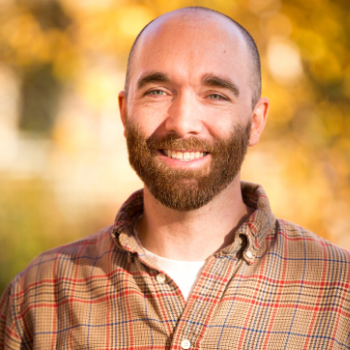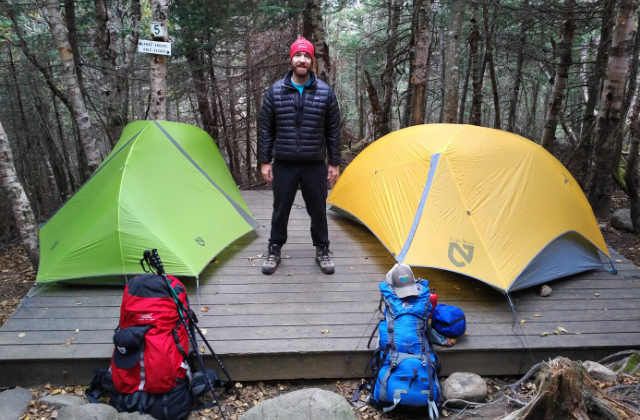When teenage Patrick McCluskey wasn’t hiking, camping, or rock climbing with family and friends, he could often be found racing mountain bikes in amateur slalom races or hiking the half-pipe with a snowboard under his arm.
He chose a college—University of Colorado, Boulder—primarily due to the nearby snowboarding and rock climbing areas. But while the mechanical engineering major reveled in mountaintop vistas, he was also enthralled by the view through a microscope. As an undergraduate research assistant, he became fascinated by shape memory polymers.
“It was a new and exciting field and I just wanted to learn everything I could about it. I was drawn to the mechanics of materials and this interesting, abstract way to understand a physical object,” said McCluskey, S.M. ’06, Ph.D. ’11. “I enjoyed the challenge of not being able to experience it directly, but having to theorize about it and perform experimentation to get at the intricate properties of a material that couldn’t be ascertained by the hand or the eye.”
The research challenged him to measure a material’s mechanical properties at a miniscule scale. While the experiments were not always successful—he recalls breaking many fragile measurement devices—he was hooked on research.
A native New Englander, he decided to come back East for graduate school, enrolling in the engineering sciences Ph.D. program at the Harvard John A. Paulson School of Engineering and Applied Sciences.
“I didn’t always have an easy time with school. I had to work really hard to be successful in my undergrad program, so part of why I wanted to go to Harvard was to prove to myself that I could do it and that I could be successful alongside some of the greatest researchers in the world,” he said.
In the lab of Joost Vlassak, Abbott and James Lawrence Professor of Materials Engineering, he built an array of nanocalorimetry devices to probe the thermal properties of novel materials at the nanoscale. It was a new way of looking at materials that shed light on how properties vary due to a material’s length-scale and composition, he explained.
Since they were working in largely uncharted territory, even designing experiments was difficult. He and his lab mates often had to trouble-shoot how to keep tiny material samples from being destroyed as they were heated and cooled.
“It was especially exciting to be faced with a challenge and find a workaround to it, and then find other benefits from that workaround that led to unexpected results that ended up being beneficial to the research,” he said. “It was rewarding to be able to add to the body of knowledge.”
Their work had applications in the micro-electromechanical systems and shape memory alloys that are at the cutting-edge of materials science, he said.
Excited by the potential of applied research, he joined the coatings group at the GE Global Research Center after graduation.
Among his favorite projects was the development of an additive manufacturing process known as cold spray. The cold spray process accelerates microscopic particles to supersonic speeds using jets of nitrogen or helium gas. As these particles impact on a surface, they can form coatings and, with continued layering, build up to form 3D structures. The process that he optimized was used to build airfoils for jet engines.
“I soon found that in industry, you are not granted the time you have during a Ph.D. program to really dig deep into what you are doing. You have to find solutions at a fast pace because the business depends on it,” he said. “You end up exploring these new areas as fast as you can, doing research and experimental trials, then learning and repeating the process.”
While McCluskey thrived under pressure, he began looking for a smaller firm that would enable him to see projects through from beginning to end.
He found an ideal fit for both his materials science know-how and love of the outdoors at NEMO Equipment, a company that designs innovative outdoor gear.
As director of engineering, McCluskey oversees the technical aspects of product development and design. He works with all sorts of material types, from the aluminum in tent poles to weather-resistant fabrics that have multiple coatings, all with different properties.
Understanding each of those materials and how they work together in a single product is a fun challenge, he said.
“I’ve really enjoyed delving into tent fabrics lately and learning all I can about them so we can lead the industry through technical fabric innovation,” he said. “There are a lot of requirements placed on tent fabrics—they need to be light weight, have high tear strength, and be water repellent and resistant. The fabrics are getting much more technical as a result.”
Staying on top of the latest materials keeps McCluskey busy. He also enjoys thinking about products from a customer’s point of view, drawing on his expertise as an avid outdoorsman.
For instance, his experiences as a camper informed the design of a new camp chair style that swings and reclines, while his materials science expertise helped him keep the finished product to about five pounds.
“Researching something initially, coming up with design ideas, doing all the engineering work, bringing that to production, and then watching it go out into the world is a really satisfying process,” he said. “And to be able to help other people experience the outdoors and find a passion for it the same way I did is very rewarding.”
Press Contact
Adam Zewe | 617-496-5878 | azewe@seas.harvard.edu




